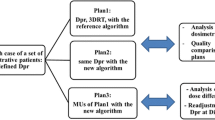Abstract
This study investigates the effect of 2, 3, 5 and 10% dose uncertainty per fraction during radiotherapy on tumour control probability. Although undesirable 10% dose uncertainties is also possible and are, therefore, also investigated in this article. Different timing schemes and dose per fraction are considered. These are standard (conventional) fractionation and stereotactic body radiotherapy (hypofractionation). The purpose of this article is to find the impact of dose uncertainty on treatment outcome in terms of tumour control probability (TCP). The impact of dose uncertainty on normal tissue complication probability will be explored in future work. In order to investigate the impact of such uncertainty, a MATLAB code has been developed that simulates tumour irradiation with different fractions and dose per fraction. Zaider–Minerbo–Stavreva TCP model was used for the calculations, as well as linear-quadratic model of cell killing and histograms of the tumour control probability are obtained for different treatment regimens. This study shows that dose uncertainty plays significant role in treatment outcome. According to (ICRU International Commission on Radiation Units and Measurements, Determination of absorbed dose in a patient irradiated by beams of X or gamma rays in radiotherapy procedures, ICRU Report 24, ICRU, Bethesda 1976; International Atomic Energy Agency, Absorbed dose determination in external beam radiotherapy, Technical Reports Series No. 398, IAEA, Vienna 2000), the accuracy in the delivery of absorbed dose should be ± 5% at the level of two standard deviations, which correspond to a combined uncertainty of 2.5% at the level of one standard deviation. All the results mentioned here are at level of one standard deviation (SD). Still nowadays, 2% dose uncertainty (1% at level 1 SD) is practically unattainable because of dosimetry limitations. Even ionising chambers that are used for treatment unit commissioning and regular QA are calibrated with uncertainty around 1–1.5% (https://www.ptwdosimetry.com/) at 2 SD meaning that at that moment it is practically impossible to achieve combined uncertainty of 2% (2 SD). Therefore, we consider at best 2% (1 SD) dose uncertainty can be achieved and for the sake of experiment we investigate the impact of 1% (1 SD) dose uncertainty in treatment outcome. The obtained results show that the smaller the fractions and the larger the doses, the greater the impact of dose uncertainty on TCP especially in the steepest part of the curve. For the case of 1 fraction with 23.875 Gy even with 2% dose uncertainty the results are: TCPmean = 24.74 ± 10.75%. Unreproducible in practice 1% dose deviation leads to: TCPmean = 24.17 ± 5.63% which is still not a satisfactory result.



Similar content being viewed by others
Data availability
No data associated in the manuscript.
References
ICRU International Commission on Radiation Units and Measurements. Determination of absorbed dose in a patient irradiated by beams of X or gamma rays in radiotherapy procedures, ICRU Report 24, ICRU, Bethesda (1976)
International Atomic Energy Agency. Absorbed dose determination in external beam radiotherapy, Technical Reports Series No. 398, IAEA, Vienna (2000)
https://www.ptwdosimetry.com/. Accessed 1 Aug 2022
D. Twhaites, J. Phys Conf. Ser. 444, 012006 (2013)
N.A. Stavrev et al., The impact of different timing schedules on prostate HDR-mono-brachytherapy. A TCP modeling investigation. Cancers 13(19), 4899 (2021)
N.A. Stavreva et al., Investigating the effect of clonogen resensitization on the tumor response to fractionated external radiotherapy. Med. Phys. 32(3), 720–725 (2005)
P.V. Stavrev, N. Stavreva, R. Ruggieri, A.E. Nahum, P. Tsonev, D. Penev, D. Pressyanov, Theoretical investigation of the impact of different timing schemes in hypofractionated radiotherapy. Med. Phys. 48(7), 4085–4098 (2021). https://doi.org/10.1002/mp.14908. (Epub 2021 May 31)
M. Zaider, G.N. Minerbo, Tumour control probability: a formulation applicable to any temporal protocol of dose delivery. Phys. Med. Biol. 45(2), 279–293 (2000). https://doi.org/10.1088/0031-9155/45/2/303
K.H. Chadwick, H.P. Leenhouts, A molecular theory of cell survival. Phys. Med. Biol. 18(1), 78–87 (1973). https://doi.org/10.1088/0031-9155/18/1/007
A.M. Kellerer, H.H. Rossi, The Theory of Dual Radiation Action (Department of Radiology, Radiological Research Laboratories, College of Physicians and Surgeons, Columbia University, New York, 1974)
P. Stavrev, N. Stavreva, R. Ruggieri, A. E. Nahum, D. Pressyanov. Analysis of tumour dose-response data from animal experiments via two TCP models accounting for tumor hypoxia and resensitization. Phys. Eng. Sci. Med. (in press)
J. Fischer, J.E. Moulder, Steepness of dose-response curve in radiation-therapy—theoretical considerations and experimental results. Radiology 117, 179–184 (1975)
J.F. Fowler et al., Optimum fractionation in X-ray treatment of C3H mouse mammary tumours. Br J Radiol. 47(563), 781–789 (1974)
P. Stavrev, R. Ruggieri, N. Stavreva, S. Naccarato, F. Alongi, Applying radiobiological plan ranking methodology to VMAT prostate SBRT. Phys. Med. 32(4), 636–641 (2016)
Author information
Authors and Affiliations
Corresponding author
Rights and permissions
Springer Nature or its licensor (e.g. a society or other partner) holds exclusive rights to this article under a publishing agreement with the author(s) or other rightsholder(s); author self-archiving of the accepted manuscript version of this article is solely governed by the terms of such publishing agreement and applicable law.
About this article
Cite this article
Penev, D., Stavrev, P., Stavreva, N. et al. Influence of dose uncertainty on TCP estimates: a model study. Eur. Phys. J. Spec. Top. 232, 1543–1547 (2023). https://doi.org/10.1140/epjs/s11734-023-00880-y
Received:
Accepted:
Published:
Issue Date:
DOI: https://doi.org/10.1140/epjs/s11734-023-00880-y




